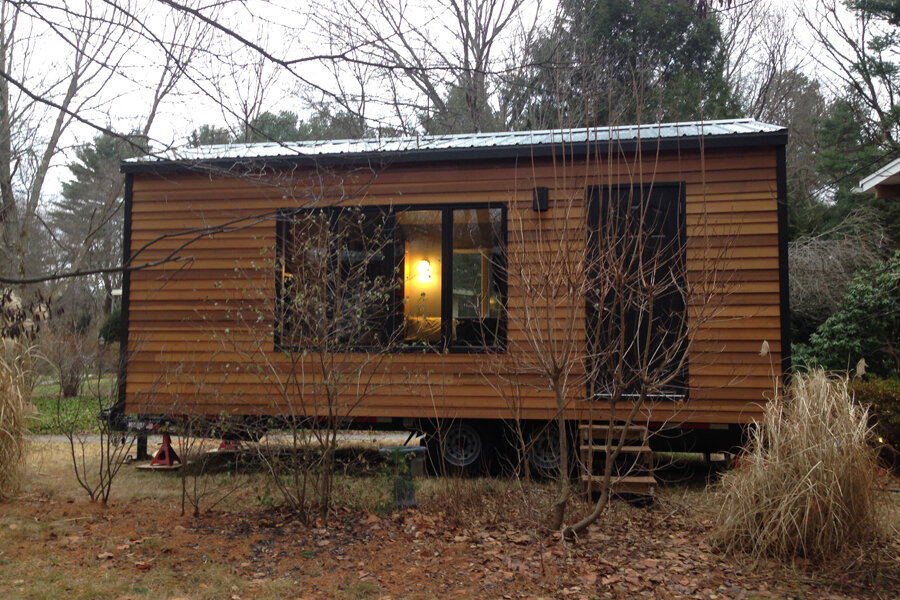Three ways to finance a tiny house
Could you live in a 400-square-foot home? How about one that comes with just 100 square feet of living space?
People are doing this. They're joining the tiny house movement, living in homes that are 500 square feet or smaller. The proponents of this kind of living say that larger homes are wasteful, full of space that no one ever uses. (See also: Mind-Blowing Tiny Houses With Huge Design Inspiration)
There is a challenge, though, with living small. And it's not just the struggle to fit sleeping, cooking, and dining spaces into a 400-square-foot space. Many who want a tiny home can't afford to purchase one with cash. They need to finance their tiny home. That's not always easy.
Financing Challenges
You might want to take out a traditional mortgage loan to finance your tiny home. But your bank might not consider it an actual home, especially if it is portable. And if banks don't consider your tiny home a real home, it won't qualify for a mortgage loan.
Even if your tiny home does meet banks' lending requirements, you might struggle to find mortgage lenders willing to do the work involved in originating a small home loan because they might not earn enough on a home loan of $50,000, $30,000 or less to make the work worth their efforts.
"Lenders have to go through the same process for a $50,000 mortgage loan as they do for a $400,000 loan," said Peggy Burke, vice president and mortgage banker with PrivatePlus Mortgage in Atlanta. "The underwriters still have to go through the same steps to approve a borrower. There still needs to be title insurance. They still have to prepare the loan documents. So banks are still incurring the same costs they would for a larger loan."
And tiny homes aren't free. They are cheaper than traditional homes, but The Tiny Life — devoted to small-home living — says that the average cost of a tiny house is $23,000 if homeowners build them from a kit. If homeowners use a builder for their tiny home, they can expect to pay twice that amount.
Financing Options
The Tiny Life says that 68 percent of the owners of tiny homes don't have mortgages. But what if you're one of the 32 percent of owners who need to somehow finance the cost of a tiny home? You do have options.
Home Equity Loan
The easiest choice might be if you are building a tiny home as a second home or vacation home. Burke says that owners with a first home can tap the equity in these residences to take out a home equity loan or home equity line of credit. They can then use these loans to finance the construction of a tiny home.
You need equity in an existing home to take out such a loan. Say your primary residence is worth $220,000 and you owe $150,000 on that home's mortgage loan. You then have $70,000 worth of equity. Most lenders will loan you a percentage of that figure in the form of a home equity loan or home equity line of credit.
RV Loan
But what if you don't own another home? What if you want your tiny home to be your only home? Todd Nelson, business development officer at LightStream, the online lending division of Richmond, Virginia-based SunTrust Bank, says that many tiny homes can be financed with an RV loan.
Such homes must first be certified by the Recreation Vehicle Industry Association as actual RVs. Nelson said that many tiny home manufacturers today are gaining this certification as a way to make it easier for consumers to finance their residences.
Unsecured Loan
Some banks will provide unsecured personal loans that consumers can use to finance small homes. An unsecured loan is one that does not use a property as collateral. A typical mortgage loan is a secured one; if you miss enough mortgage payments, your lender will take possession of your home through the foreclosure process.
Unsecured loans, because there is no such collateral, are riskier for lenders, so they typically charge higher interest rates. Some banks, though, specialize in unsecured loans and provide lower-than-expected interest rates.
How do consumers qualify for an unsecured loan? Nelson says that lenders at LightStream look at borrowers' credit histories, incomes, assets, and debts. Borrowers with high credit scores, low debt, a steady job, and strong incomes are more likely to qualify for an unsecured loan.
"We don't want to lend to someone who struggles to pay our loan back," Nelson said. "It's all about stable income and a history of using credit and credit cards wisely in the past."
Nelson says that he expects financing for tiny homes to become more common in the future. That's because the tiny home movement — though still a fraction of the overall housing market — is growing.
"These tiny houses have become something of a phenomenon," Nelson said. "We are seeing Millennials who have no interest in buying cars and want a simpler, more affordable form of living buying these homes. But we are also seeing retirees looking at tiny homes when it's time for them to downsize or if they want a second home."





